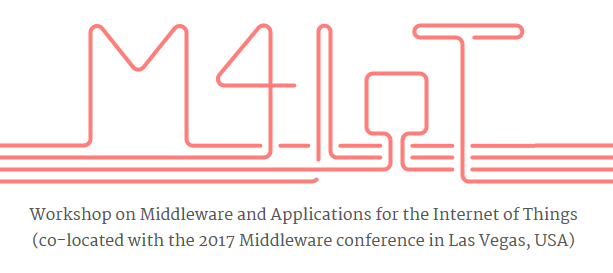M4IoT 2017 CFP
=====================================================
Workshop on Middleware and Applications for the Internet of Things
Fourth edition of the M4IoT workshop, and second federated event with
the MoTA workshop
At the ACM/IFIP/USENIX Middleware 2017 Conference
Las Vegas, Nevada
Dec 11-15, 2017
=====================================================
Following the successful 2016 edition of the federated workshop on
Middleware and Applications for the Internet of Things, we are happy to
announce the 2017 edition. We are looking forward your submissions.
IMPORTANT DATES
– Paper submission: September 4th, 2017
– Author notification: September 28th, 2017
– Camera-ready copies: October 15th, 2017
CALL DESCRIPTION
The Internet of Things (IoT) is creating new services and applications
across various domains, including smart grids, intelligent
transportation, healthcare, smart homes, and energy management. As a
consequence, a complex ecosystem of interconnected applications,
services, as well as physical and virtual devices emerges. In this
ecosystem, enabled by corresponding middleware, devices share contextual
data or receive control commands; services consume, process, and/or
provide data; and applications leverage services and devices to fulfill
users’ needs. This workshop focuses on two fundamental componentsin such
ecosystems: the middleware that enables composition of applications,
services, and devices; and the applications built on top of such
middleware. Central topics of interest include the architecture of these
components, how they process data, how they communicate with one
another, and the process of how they are designed, implemented, and
operated.
Specific topics of interest include, but are not limited to:
– Abstractions and API composition for IoT applications
– Design and specify views, abstractions and APIs for IoT
applications, sensors and devices
– Middleware concepts enabling end users to interconnect devices and
applications (e.g., via APIs)
– Architectural concerns for building IoT applications
– Integration of IoT devices and cloud resources as well as ensuing
interaction patterns
– Composition and interoperability of IoT services
– Software engineering for IoT applications
– Development methodologies, tools, and experience
– Speed of prototyping and ease of deployment of user-programmable
content
– Services and infrastructure for IoT applications
– Services on the cloud and the edge for the IoT
– Data management for the IoT
– Design of IoT platforms and experience of using IoT platforms
(e.g., FIWARE)
– Distribution of services and applications over sensors, mobile
devices, edge, fog, and cloud resources
– Semantic web services for the IoT
– Discovery and capability matching services
– Simulated IoT infrastructure and testbeds
– Processing paradigms and services
– Stream processing and distributed event-based systems
– Complex event processing for the IoT
– Intelligent data transformation services
– Quality aspects
– Security and privacy
– Quality of context capabilities
– Access control, especially in systems spanning multiple
administrative domains
– System-wide quality concerns such as performance, availability,
and fault-tolerance
WORKSHOP CO-CHAIRS
– Thaís Vasconcelos Batista, Federal University of Rio Grande do Norte,
Brazil, (thais@ufrnet.br)
– David Bermbach, Technische Universität Berlin, Germany
(db@ise.tu-berlin.de)
– David Eyers, University of Otago, New Zealand (dme@cs.otago.ac.nz)
– Danny Hughes, Leuven University, Belgium (danny.hughes@cs.kuleuven.be)
– Chantal Taconet, Télécom SudParis, France
(chantal.taconet@telecom-sudparis.eu)
– Erik Wittern, IBM T.J. Watson Research Center, USA (witternj@us.ibm.com)
– Stéphane Delbruel, Leuven University, Belgium
(stephane.delbruel@cs.kuleuven.be)
Contact all the co-chairs: m4iot.workshop@gmail.com
SUBMISSION INSTRUCTIONS
M4IoT 2017 seeks two kinds of paper submissions:
– 6-page research papers. They should clearly demonstrate how a concrete
research challenge is solved in a novel way.
– 4-page experience reports. They should report on practical experiences
as well as clearly identify concrete research challenges that were
encountered.
Please indicate the respective paper type on the title page of your
submission
All papers should follow ACM formatting instructions. Along with the
paper, you are encouraged to submit additional material (e.g., a link to
a YouTube video) on a separate page which will not be published as part
of the proceedings. We will later add the link to the submission site.
The required format for the submission is the ACM SIG Proceedings
Standard Style.
Papers should describe original work (not submitted or published
elsewhere) and be not more than six pages in length, including the
abstract, all figures, tables, and references.
Submitted papers should adhere to the formatting instructions of the ACM
Standard Style. The author kit containing the templates for the required
style can be found here:
http://www.acm.org/sigs/publications/proceedings-templates
Papers must be submitted in PDF format via the submission site:
https://m4iot17.hotcrp.com/
PUBLICATION
All accepted and presented papers will appear in a Middleware 2017
companion proceedings, which will be available in the ACM Digital Library.

